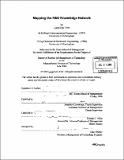| dc.contributor.advisor | Jonathon Cummings. | en_US |
| dc.contributor.author | Liew, Kou-Yew, 1972- | en_US |
| dc.contributor.other | Massachusetts Institute of Technology. Management of Technology Program. | en_US |
| dc.date.accessioned | 2005-06-02T18:44:48Z | |
| dc.date.available | 2005-06-02T18:44:48Z | |
| dc.date.copyright | 2004 | en_US |
| dc.date.issued | 2004 | en_US |
| dc.identifier.uri | http://hdl.handle.net/1721.1/17806 | |
| dc.description | Thesis (S.M.M.O.T.)--Massachusetts Institute of Technology, Sloan School of Management, Management of Technology Program, 2004. | en_US |
| dc.description | Includes bibliographical references (leaves 55-57). | en_US |
| dc.description.abstract | Knowledge networks have received a significant amount of attention in the past few decades as people look beyond corporate governance and resource-based approaches to uncover sources of competitive advantage. While this area of research is useful for organizations in general, it is especially pertinent to R&D organizations where knowledge flow is the critical enabler for breakthrough innovation. The proposed thesis will examine the drivers of knowledge flow and how it impacts the performance of Functional Centers and its subunits. The core of this research focuses on a medium-sized R&D firm in Singapore. This work is divided into the following steps: Develop a structured interview for gathering ideas from senior managers, Create and execute a survey to assess the knowledge network, Process and analyze the results This thesis will investigate the following questions: What are the various approaches people use to form their working networks and which approaches generate the most contacts and which methods generate the most useful contacts. Does strong intra-center/subunit connectivity negatively impact inter-center/subunit connectivity with people from other groups? How does the presence of people with strong networks within the centers affect the performance of the group? Do the managers of these people recognize their value/contribution and how does it affect the usefulness of these connectors? How does the duration of a bond between two people affect the quality of its social and work-related interactions? How does the willingness to build cross-level bonds (managers and junior engineers) impact the performance and efficacy of managers hence their workgroups? | en_US |
| dc.description.statementofresponsibility | by Liew Kou-Yew. | en_US |
| dc.format.extent | 64 leaves | en_US |
| dc.format.extent | 4268678 bytes | |
| dc.format.extent | 4273624 bytes | |
| dc.format.mimetype | application/pdf | |
| dc.format.mimetype | application/pdf | |
| dc.language.iso | eng | en_US |
| dc.publisher | Massachusetts Institute of Technology | en_US |
| dc.rights | M.I.T. theses are protected by copyright. They may be viewed from this source for any purpose, but reproduction or distribution in any format is prohibited without written permission. See provided URL for inquiries about permission. | en_US |
| dc.rights.uri | http://dspace.mit.edu/handle/1721.1/7582 | |
| dc.subject | Management of Technology Program. | en_US |
| dc.title | Mapping the R&D knowledge network | en_US |
| dc.title.alternative | Mapping the research and development knowledge network | en_US |
| dc.type | Thesis | en_US |
| dc.description.degree | S.M.M.O.T. | en_US |
| dc.contributor.department | Management of Technology Program. | en_US |
| dc.contributor.department | Sloan School of Management | |
| dc.identifier.oclc | 56556967 | en_US |
